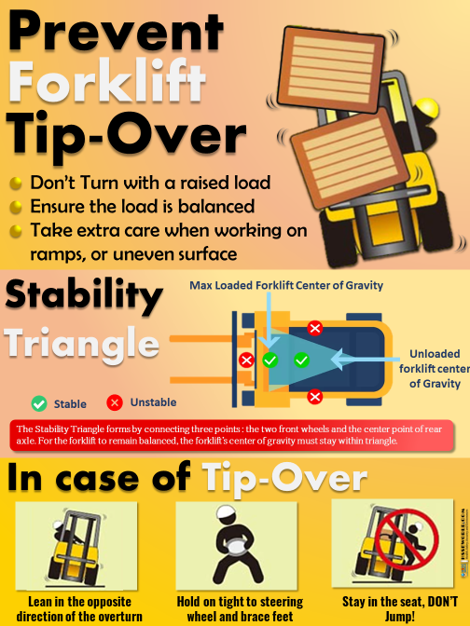In July 2020, a Prince Edward Island worker was fatally injured when struck by an airborne broken chain.
An excavator was being used to try to tow the loader, which was stuck in soft soil. The two pieces of machinery were facing each other and a chain and rope assembly were attached to both for towing. The chain broke under pressure and became airborne, striking the worker who was still in the cab operating the loader.

The following hazards may have contributed to the workplace fatality and could have been managed to prevent the fatality:
- The chain used for towing was not strong enough for the conditions. The weight of the heavy equipment, plus the additional force required to move the stuck machinery, had not been adequately calculated.
- The tow rope and chains used at the scene of the accident were not marked or labeled with the maximum working load limit to determine if they were strong enough.
- Improper attachment of the chain to The excavator bucket created a pinch point causing the chain to fail.
- The location of the chain attachment on the equipment positioned the operators in the direct line of the tow. Operators were in a danger zone and at risk of injury should towing equipment fail.
- The connected chains and rope had different strength capacities. Different types of rigging should never be combined to complete a towing task.
- Neither piece of equipment had engineered anchor points to allow chains, slings or straps to be attached.
- Workers lacked safe towing education, training, and practices.
Recommended Precautions
The following precautions are recommended when towing equipment:
- Ensure workers are adequately trained on safe equipment use and safe towing practices.
- Complete a hazard assessment, ahead of the towing process, to determine the risks and establish safety zones.
- Consider soil and surface conditions. Assess the condition of the ground under the pulling vehicle and the equipment that is stuck.
- Complete an inspection of the chains, hooks, clevises, tow ropes, heavy machinery, and any other equipment used in the towing process before and after use.
- Ensure tow chains are clearly marked with the size and grade to allow for proper towing calculations.
- Ensure the maximum working load limit of the towing equipment before beginning the towing process.
- Consider the total weight of the stuck equipment and any attached implements.
- Consider the extra working load that the mud will create. The deeper the equipment is stuck the greater the suction force that holds it in place.
- Account for the resistance the stuck vehicle or equipment confronts when it is pulled forward against the soil pushed in front of the tires.
- Use one length of chain that is of adequate length and strength for the specific towing task. Avoid
- combining multiple chains or straps together.
- Attach chains, clevises, slings, tow ropes, or straps to the machinery’s engineered anchor points.
- Use edge protectors any time ropes or straps touch a part of the equipment.
- Ensure the tip of the hook faces up. It will fall toward the ground if it breaks or comes off while pulling.
- Do not attach horizontal tow chains at the same height or above the position of the operators.
- Ensure the operator of the towing vehicle and the driver of the stuck equipment are the only persons in the vicinity of either vehicle (Danger Zone) as it begins to tighten the strap, cable, or chain. Bystanders shouldn’t be within 100ft of the area, under any circumstances, when towing is in progress.
- Ensure safe work procedures are followed and personal protective equipment is worn to decrease the risk of injuries.
These flashes summarise key safety matters and incidents, allowing wider dissemination of lessons learned from them. The information below has been provided in good faith by members and should be reviewed individually by recipients, who will determine its relevance to their own operations. The effectiveness of the safety flash system depends on receiving reports from members in order to pass on the information and avoid repeat incidents.
Source and download
Legislated Requirements
The following legislative requirements under PEI’s Occupational Health and Safety (OHS) Act relate to this hazard alert:
OHS Act, Section 12(1)
(a) An employer shall ensure that every reasonable precaution is taken to protect the occupational health and safety of persons at or near the workplace.
(b) That any item, device, or machinery provided for the use of workers at a workplace is properly maintained, and is properly equipped with safety features or devices, as recommended by the manufacturer or required by the regulations.
(c) That such information, instruction, training, supervision, and facilities are provided as are necessary to ensure the occupational health and safety of the workers.
(E) That the employer’s undertaking is conducted so that workers are not exposed to occupational health and safety hazards as a result of the undertaking.

Read More Safety Flash
- Safety Flash: Mobile concrete placing boom overturn incidents
- Safety Flash: Not Following Work permit and Isolation Procedure
- Safety Flash: Floorman arm pinned by Pipe Handling Equipment
- Safety Flash: Suspension Trauma
- Safety Flash: Fatality: explosive failure of corroded fire extinguisher
- Safety Flash: Crewman fell to his death through faulty grating
- Safety Flash: Fatal accident during cargo operations on Karina C
- Safety Flash: Overturning of the Lifeboat Kristin Faye
- Safety Flash: Short circuit on 440v AC bus bars-arc flash
- Safety Flash: Towing Fatality
- Safety Flash: Unsafe lifting operations
- Safety Flash: Electric Shock Resulting in Burn
- Safety Flash: LTI- Loss of Finger Tip and Nail
- Safety Flash: Explosion And Fire Onboard The chemical Tanker STOLT Greenland
- Safety Flash: Finger injury caused by incorrectly secured console cover
- Safety Flash: double Man overboard Resulting in one fatality
- Safety Flash: Alcohol-based hand sanitizer warning
- Safety Flash: Dump truck operator fatally electrocuted by high-voltage line
- Safety Flash: Laborer Dies After Footing Collapse – North Carolina
- Safety Flash: Reducing the risk of propane explosions in food trucks
- Safety Flash: Teen Roofer Electrocuted when Ladder Contacts High Voltage Power Line
- Safety Flash: Worker dies from carbon monoxide poisoning while using pressure washer
- Safety Flash: Explosion during welding operation
- A Bathtub Refinisher Dies from Methylene Chloride Exposure :Safety Flash
- Landscaper dies after auger entanglement:Safety Flash
- Worker dies after falling from scaffold
- Fatality Investigation: Orchard Worker Dies After Falling Off Tractor
- LTI: Fall from height leading to Multiple Fractures
- Operator dies when forklift falls off loading dock
- Worker struck, killed by outrigger
- Worker killed by platform
- Scaffolding Components
- Construction Worker Killed When Pipe Rolls Off a Trailer
- Near-Miss: Shackle Configuration
- Improper use of lifeline results in death of worker




